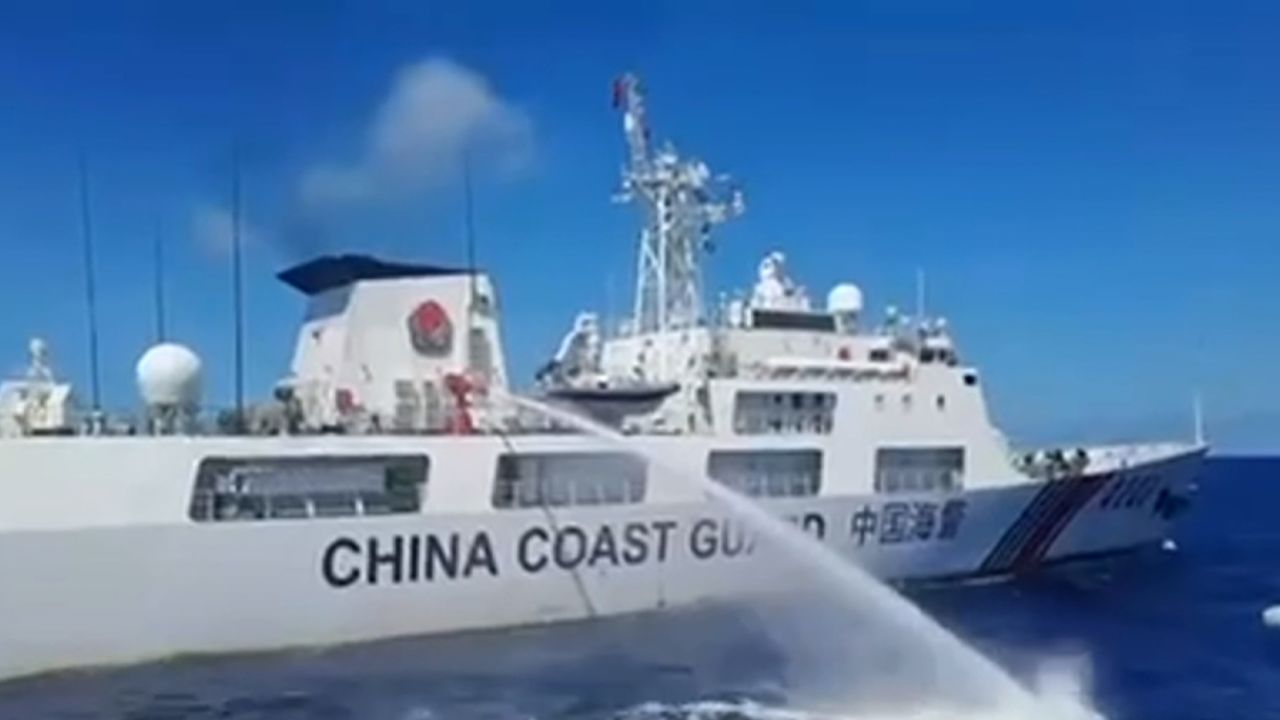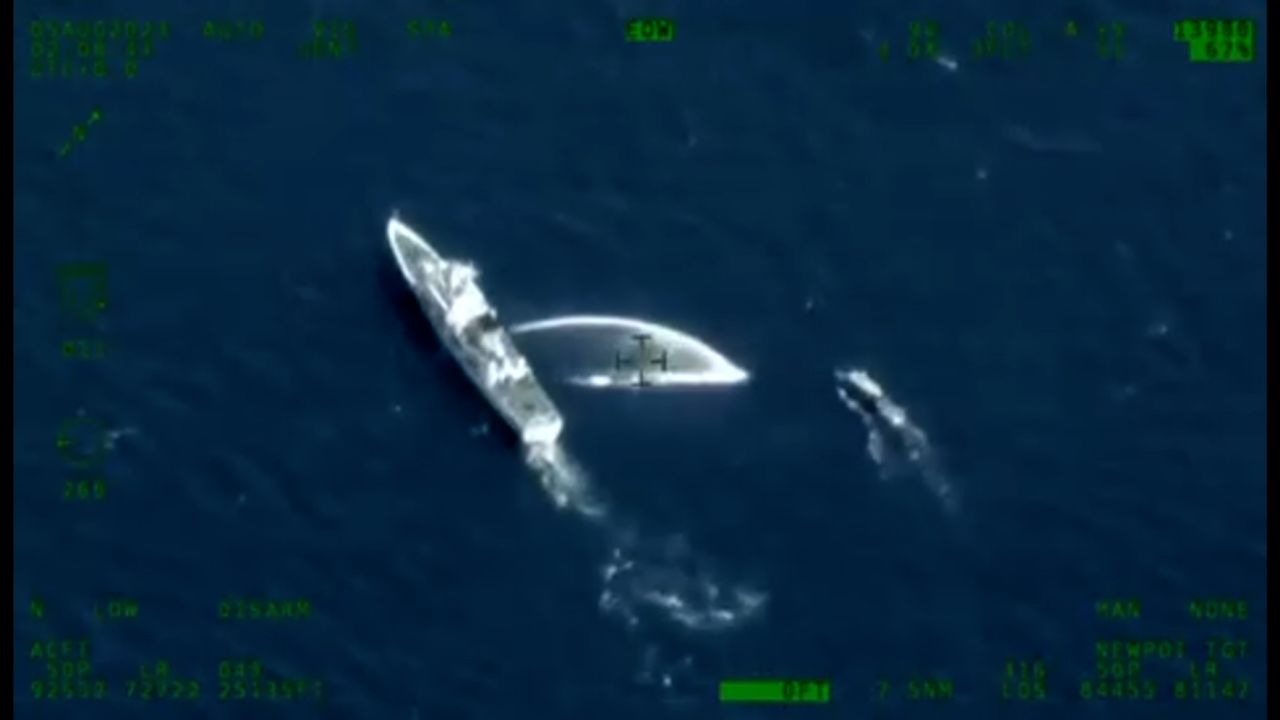China is facing a growing international backlash after one of its coast guard vessels used a water cannon against a Philippine boat in the South China Sea on Saturday, an incident analysts say escalates an already tense situation and could see the United States and its allies speed up plans for joint patrols in the waterway.
Video from the Philippines showed a large Chinese Coast Guard ship spraying a much smaller Philippine boat that was attempting to deliver supplies to a garrison of Philippine marines on Second Thomas Shoal, a South China Sea feature in Manila’s exclusive economic zone that China calls Renai Reef and also claims as its sovereign territory.
Images from the Philippine Coast Guard also showed the Chinese ship moving dangerously close in front of the Philippine Coast Guard vessels as they escorted the resupply boats.
By Sunday, Manila’s main ally, Washington, condemned the Chinese actions and reiterated that it would meet its mutual defense treaty obligations with the Philippines.
“The United States reaffirms an armed attack on Philippine public vessels, aircraft, and armed forces — including those of its Coast Guard in the South China Sea — would invoke US mutual defense commitments under Article IV of the 1951 US Philippines Mutual Defense Treaty,” US State Department spokesperson Matthew Miller said in a statement.
US allies joined in a united front with Washington and Manila.
Australia, Japan and Germany called the Chinese actions “dangerous” and “destabilizing.”
And the Canadian Embassy in Manila said Ottawa “unreservedly condemns the dangerous and provocative actions taken by the Chinese Coast Guard.”

Philippine President Ferdinand Marcos Jr. said on Monday his foreign affair secretary delivered a diplomatic note of complaint “along with images and videos on what had happened” to the Chinese ambassador in Manila.
Meanwhile, the Philippine Foreign Ministry and armed forces held a joint press conference condemning what they called China’s “dangerous and illegal practice” of using water canon, saying the action put “the lives of the Filipino crew at risk in violation of humanitarian and international law.”
Longstanding dispute
The South China Sea has long been a source of tension between Manila and Beijing.
Beijing claims “indisputable sovereignty” over almost all of the 1.3 million square mile South China Sea, as well as most of the islands within it, even those hundreds of miles from the Chinese mainland.
That includes the Spratlys, which Beijing calls the Nanshas, an archipelago consisting of 100 small islands and reefs also claimed in full or part by the Philippines, Malaysia, Brunei and Taiwan.
Manila, however, calls the area the West Philippine Sea. In 1999 it intentionally grounded a navy transport ship, the BRP Sierra Madre, on Second Thomas Shoal, manned by Filipino marines, to enforce the country’s claim to the area.
Manila’s claims are backed by the international Permanent Court of Arbitration in the Hague, which ruled in 2016 that China has no legal basis to claim historic rights to the bulk of the South China Sea.
Beijing has ignored the ruling.
Analysts and Philippine politicians called Saturday’s incident a step up from a string of Chinese-Philippine confrontations this year, including a Chinese ship aiming a laser at a Philippine vessel in February and then a series of close encounters analyst Collin Koh called “near collisions.”
“Clearly this latest incident represents an escalation,” said Koh, research fellow at the S. Rajaratnam School of International Studies in Singapore.
m”I really believe we’re entering the period of brinkmanship diplomacy,” Philippine Sen. Alan Peter Cayetano told CNN affiliate CNN Philippines.
“If something goes wrong, it can really cause instability in the region,” he said.
But China shows no sign of backing off its claims.
“Two Filipino supply vessels and two coast guard vessels illegally intruded into the waters adjacent to Renai Reef in China’s Nansha Islands,” Gan Yu, spokesman for the China Coast Guard, said according to the statement published on its website Sunday.
Gan reasserted Chinese territorial claims on the islands and the South China Sea and vowed to continue law-enforcement activity within the region.
And on Monday, China’s coast guard, in a statement, accused Manila of trying to “permanently occupy” Chinese sovereign territory.
It said it fired water cannons as a warning to prevent collision after multiple warnings, and characterized its operation as “professional, restrained and justifiable.”
Jeffrey Ordaniel, director of maritime security at the Pacific Forum and an assistant professor at Tokyo International University, said Beijing could be expected to continue what he called its “gray zone” tactics, actions just below the use of weapons that would trigger the US-Philippine mutual defense treaty.
Blake Herzinger, a research fellow at the United States Studies Center in Australia, called the international denunciation of Beijing encouraging, but said Manila needs to do more than line up support for its claims.
“Diplomatic response will not stop this kind of maritime aggression, and so (the) Philippines is going to need to come up with a more holistic response to combine action with its diplomatic campaign,” he said.
Koh said that could see the US and the Philippines speeding up plans for joint patrols in the South China Sea, something that US Defense Secretary Lloyd Austin and his Philippine counterpart, Gilberto Teodoro Jr., said last month would be coming in the future.
Reports also say Australia and Japan could participate in patrols with the Philippines and US.
At Monday’s Philippine government press conference, Jonathan Malaya, National Security Council assistant director general, said Manila will continue to file diplomatic protests no matter what the reaction is from the Chinese side because failing to do so may be construed by China and the international community as an abandonment of its position to assert sovereignty.
“This government will not lose an inch of our territory,” Malaya said.
Koh said Washington will need more than just words to deter Beijing.
The US will “need to be seen to walk the talk and not give the impression that Beijing continues to coerce and escalate its actions without repercussions,” Koh said.
Ordaniel agreed.
“The Americans,” he said, “have a choice to make.”
“If US responses continued to be limited to statements and perhaps military exercises, Beijing will continue to succeed in changing the status quo.”
Source: CNN











